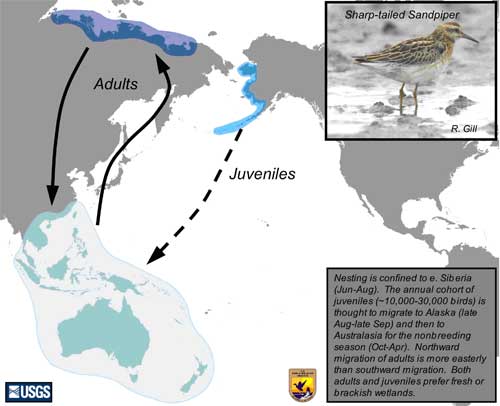Sharp-tailed Sandpiper, Calidris acuminata
High-Priority Species ListSampling locations: Primary locations include the central YKD (Old Chevak, Tutakoke River, Kashunuk River, Hazen Bay) and Alaska Peninsula estuaries (Ugashik Bay and Hook-Cinder Lagoon). Secondary locations include Kuskokwim Shoals, eastern Norton Sound and the St. Michael wetland complex.
Sampling timeframe: Late August through early November.
Sample demographics: Only juveniles will be sampled since they are the only age cohort to occur in Alaska. Equal numbers of males and females will be sampled (sex determined from measurements when bird in hand).
Methods of capture: Almost all samples will come from live-captures using walk-in traps and mist nets. During relatively brief periods in autumn 2004 and 2005, over 300 birds were captured on the YKD using walk-in traps and mist nets. Small numbers of samples will be obtained from alternative methods, namely feces and lethal capture (~20-40 birds).
Other targeted species: At the proposed primary sampling sites it will be possible to sample large numbers (>200) of Dunlin, Rock Sandpipers, and Bar-tailed Godwits, and small numbers of Pectoral Sandpipers and Long-billed Dowitchers
Contact: Brian McCaffery
Alaska Peninsula-Becharof NWR (August through October)
Togiak NWR (August through October)
U.S. Geological Survey
Contact: Robert Gill
Connors, P. G., and C. S. Connors. 1985. Shorebird littoral zone ecology of the southern Chukchi coast of Alaska. Pages 3-57 in Environmental Assessment of the Alaskan Continental Shelf, Final Reports of Principal Investigators, Vol. 35. NOAA, Environ. Res. Lab., Boulder, CO.
Engelmoer, M., and C. Roselaar. 1998. Geographical variation in waders. Kluwer Academic Publishers, Dordrecht, The Netherlands.
Gill, R. E., Jr. 1987. Trip report: birds and mammals observed at Ugashik Bay, Alaska Peninsula, 26 September-22 October 1986. Unpubl. Rept., U.S. Fish and Wildlife Service, Anchorage, AK.
Gill, R. E., Jr., K. S. Bollinger, and M. R. Petersen. 1985. Trip report: birds and mammals observed at Ugashik Bay and Cinder River, Alaska Peninsula, September 26-October 19, 1985. Unpubl. Rept., U.S. Fish and Wildlife Service, Alaska Fish and Wildlife Research Center, Anchorage, AK.
Gill, R. E., Jr., and C. M. Handel. 1981. Shorebirds of the eastern Bering Sea. Pages 719-738 in D. W. Hood and J. A. Calder (eds.). The eastern Bering Sea shelf: oceanography and resources, Vol. 2. Univ. Washington Press, Seattle.
Gill, R. E., Jr., and C. M. Handel. 1990. The importance of subarctic intertidal habitats to shorebirds: a study of the central Yukon-Kuskokwim Delta, Alaska. Condor 92:709-725.
Gill, R. E., Jr., and M. M. Vacca. 1987. Trip report: birds and mammals recorded at Hook Lagoon and west Cinder Lagoon, Alaska Peninsula, September 26-October 22, 1986. Unpubl. Rept., U.S. Fish and Wildlife Service, Anchorage, AK.
Higgins, P. J., and S. J. J. F. Davies (eds.). 1996. Handbook of Australian, New Zealand and Antarctic birds. Volume 3: Snipe to Pigeons. Oxford University Press, Melbourne.
Schamel, D., D. Tracy, P. G. Mickelson, and A. Seguin. 1979. Avian community ecology at two sites on Espenberg Peninsula in Kotzebue Sound, Alaska. Pages 289-607 in Environmental Assessment of the Alaskan Continental Shelf, Final Reports of principal investigators, Vol. 5. NOAA, Environ. Res. Lab., Boulder, CO.
Shields, G. F., and L. J. Peyton. 1979. Avian community ecology at the Akulik-Inglutalik River Delta, Norton Bay, Alaska. Pages 608-710 in Environmental Assessment of the Alaskan Continental Shelf, Final Reports of Principal Investigators, Vol. 5. NOAA, Environ. Res. Lab., Boulder, CO.
Woodby, D., and G. Divoky. 1983. Bird use of coastal habitats in Norton Sound. Pages 353-704 In Environmental Assessment of the Alaska Continental Shelf, Final Reports of Principal Investigators, Vol. 18. NOAA, Environ. Res. Lab., Boulder, CO.

Ranking Score: 14.5
Asian H5N1 ranking criteria for Sharp-tailed Sandpiper, Calidris acuminata.
Total of partial contact with Asia1 |
Contact with known "hot spot"2 |
Habitat used in Asia3 |
Pop. in Alaska4 |
Can samples be obtained? |
Score |
3.0 |
1.0 |
3.5 |
2.0 |
3.0 |
14.5 |
Breeding restricted to n.c. Siberia with annual cohort of immatures coming to Alaska; adults move through EAA flyway |
Adult migration passes through current known ‘hot spots’ in central e. Asia. Species of concern if adults can pass virus to offspring on breeding grounds |
Freshwater marshes, brackish wetlands, salt ponds, sewage farms, ephemeral wetlands |
10,000 - 40,000 depending on annual production |
Easy to capture in Alaska autumn |

